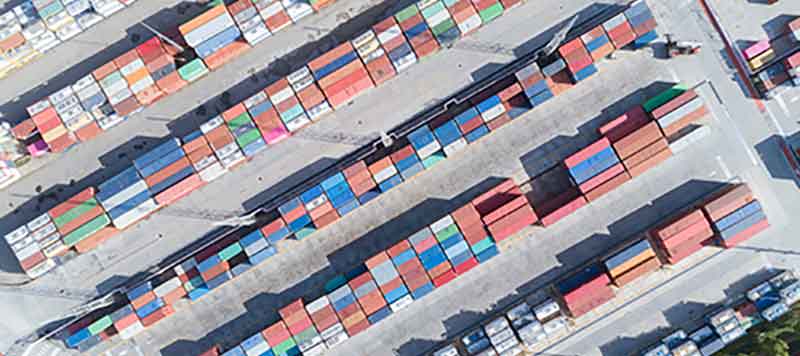In truckload shipping, there are two wide-know transportation options. Full Truckload (FTL) and Less Than Truckload (LTL). Typically, shippers always choose between these methods to move their freight. However, volume LTL, also known as volume shipment, is another cost-effective solution for cargo shipping.
In today’s article, we will discuss what volume shipment is, why to use it, and how it differs from standard LTL and partial truckload.
What is volume shipment and how it works?
Volume shipment is a shipping method that combines multiple smaller shipments from different shippers into one larger shipment to fill up the available space in a truck. It allows shippers to take advantage of cost savings and more efficient transportation.
Let’s consider an example to understand volume shipment better:
Example:
Company A want to ship three pallets of electronics from China to the USA. Each pallet weighs 1,500 pounds and takes up 60 cubic feet of space. Company A decides to use volume shipment instead of delivering these three pallets individually with LTL carriers.
In a volume shipment scenario:
Total weight: 4,500 pounds (3 pallets x 1,500 pounds each)
Total volume: 180 cubic feet (3 pallets x 60 cubic feet each)
With LTL volume, company A can combine these three pallets into one larger shipment to reduce shipping costs. The consolidated shipment will be treated as a volume LTL freight and transported with other compatible shipments in the same truck, allowing for more efficient use of the truck’s capacity.
Pros & cons of volume LTL freight
Advantages:
Cost savings: Volume LTL rates are generally lower than individual LTL rates, allowing businesses to save more on shipping costs.
Space optimization: Combining multiple smaller shipments into one larger volume shipment optimizes truck space, leading to more efficient transportation.
Reduced handling: With fewer shipments to process, there is less risk of damages and errors during loading and unloading.
Less environmental impact: Consolidated shipments results in fewer trucks on the road, reducing carbon emissions and promoting sustainability.
Improved transit times: Volume LTL shipments often have faster transit times than standard LTL because they have fewer stops and transfers.
Disadvantages:
Limited accessibility: Not all carriers offer volume LTL services, limiting the pool of available freight carriers for this shipping method.
Size and weight restrictions: Some carriers may have restrictions on the maximum size and weight of volume LTL shipments.
Less flexibility: Volume shipments may have specific pickup and delivery schedules, limiting flexibility for shippers.
Limited coverage: Volume LTL services may have limited coverage in certain regions or for specific destinations.
Potential handling challenges: Combining multiple shipments may lead to handling challenges and potential damages if not packaged and secured correctly.
It’s essential for businesses to carefully consider their shipment characteristics, quantity, and budget before shipping. Airsupply, an experienced logistics provider, can help maximize the benefits of volume LTL freight.
When to use volume shipment?
Here are some specific situations you can check:
– If your shipment size is too large for LTL but not enough to fill an entire truckload. Or if the individual LTL rates for your cargo shipping are higher than the volume freight.
– If you frequently ship similar goods to the same destination and want to streamline your logistics, offering consistency in transit times and costs.
– If your business is committed to sustainability and reducing carbon emissions while contributing to eco-friendly practices.
– When you need to expedite delivery while maintaining cost-effectiveness, volume shipment with shorter transit times can be a suitable solution.
How does volume freight differ from standard LTL?
The primary difference between volume LTL and standard one is shipment size and cost structure.
In standard LTL, individual shipments typically occupy a few pallet spaces. In contrast, volume freight combines multiple larger cargo or pallets. For instance, if you want to ship three batches of goods, you can get two different results between them:
With standard LTL: Three separate shipments, each occupying four pallet spaces (total 12 pallet spaces).
With volume freight: Three shipments combined into one larger shipment, occupying nine pallet spaces (instead of 12).
Volume LTL caters to larger shipments, typically 5,000 to 15,000 pounds or more, while standard LTL handles smaller ones of up to 5,000 pounds.
Additionally, the pricing structure for volume shipment is based on the space (cubic feet or linear feet) used in the truck. And the standard LTL rates depend on shipment weight and distance.

Volume LTL vs. Partial Truckload
Firstly, let’s know what a partial truckload is:
A partial truckload, also known as partial TL or PTL, is one of the consolidated shipments. Though it is calculated according to cubic feet/linear feet same as LTL volume, there are subtle differences between them:
Shipment size
Volume LTL: Typically involves shipments with dimensions ranging from 6 to 20 linear feet and weighing more than 5,000- 15,000 pounds.
Partial Truckload: It usually includes shipments that occupy space equivalent to 6 to 20 pallets or have a weight range of 5,000 to 27,500 pounds.
Cost comparison
Volume LTL: On average, volume LTL shipments cost around $0.20 to $0.30 per pound or $50 to $150 per linear foot.
Partial Truckload: The cost per pound for partial truckload shipping ranges from $0.10 to $0.25 or $30 to $100 per linear foot.
Transit time
Volume LTL: Typically follows a hub-and-spoke distribution model with multiple stops and potential handling at terminals, leading to longer transit times.
Partial Truckload: Offers direct transit with fewer stops and handling, leading to faster delivery times than volume shipments.
Equipment utilization
Volume LTL: Utilizes trailers equipped with logistical technology to consolidate multiple shipments and optimize space.
Partial Truckload: Leverage space on the truck that is not filled, ensuring efficient use of resources.
Selecting the most suitable option depends on the specific requirements of the shipment, budget constraints, and the urgency of delivery. An experienced logistics provider can help businesses make informed decisions and customize shipping strategies for optimal efficiency and cost savings.
How to get the best LTL volume quote?
Partnering with a reputable freight forwarder, such as Airsupply, can simplify obtaining volume shipment quotes. They have established relationships with carriers and can negotiate on your behalf to secure favorable rates.
At Airsupply, they can help you identify the freight class of your consolidated goods, which will impact the shipping cost. In addition, they also offer competitive prices and volume discounts for larger shipments.




